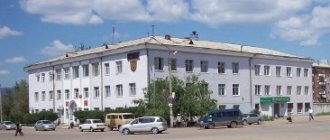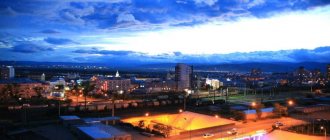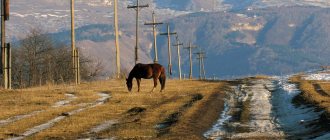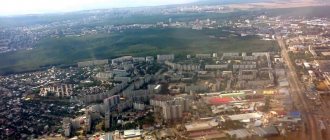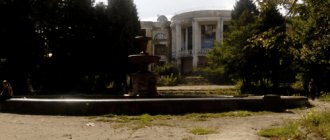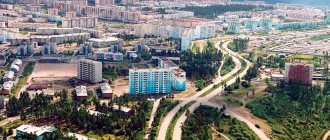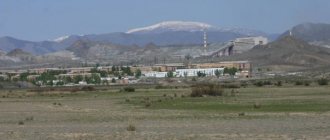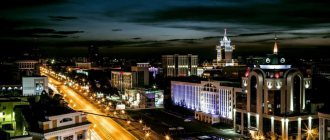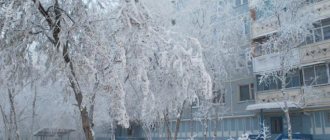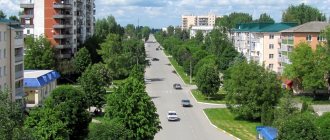Save it for yourselfPrint
In the southern part of Eastern Siberia, where the border of Russia and Mongolia passes, the Republic of Buryatia is located - an amazing region, amazing with its natural resources, diversity of traditions and cultures, and a bizarre mixture of Buddhism and shamanism.
Once these lands were part of the Great Mongol Empire, and after joining the Russian Empire, dissidents were exiled to Buryatia: Old Believers, led by the frantic Archpriest Avvakum, and later the noble Decembrists found refuge in these places.
The descendants of the “Semeyskie” (as the Old Believers are called in these places) have preserved their original dialect, traditions, beliefs and rituals to this day. Semey villages are easily recognizable by their special huts - tall, with windows decorated with bright carved frames, which are located at a height of 1.5-2 meters above the ground. Many houses have preserved traditional household utensils and colorful family outfits. By the way, the original Semeisk culture is included by UNESCO in the list of masterpieces of the intangible heritage of humanity.
Administrative structure
There are only 6 large cities (Ulan-Ude, Gusinoozersk, Zakamensk, Kyakhta, Severobaikalsk, Babushkin), 29 urban-type settlements and 614 rural settlements. The Republic of Buryatia is divided into 21 administrative districts:
- Barguzinsky
- Bauntovsky
- Bichursky
- Dzhidinsky
- Eravninsky
- Zaigraevsky
- Zakamensky
- Ivolginsky
- Kabansky
- Kizhinginsky
- Kurumkansky
- Kyakhtinsky
- Muisky
- Mukhorshibirsky
- Okinsky
- Pribaikalsky
- Severobaikalsky
- Selenginsky
- Tarbagataisky
- Tunkinsky
- Khorinsky.
The capital is Ulan-Ude.
Map of Buryatia with cities, regions and villages
| 1. Ulan-Ude | 9. Barguzin town (Barguzinsky district) | 17. Sosnovo-Ozerskoye village (Eravninsky district) | 25. Kamensk town (Kabansky district) |
| 2. Taximo town (Muysky district) | 10. Ust-Barguzin town (Barguzinsky district) | 18. Zaigraevo town (Zaigraevsky district) | 26. Selenginsk town (Kabansky district) |
| 3. Mukhorshibir village. (Mukhorshibirsky district) | 11. Khorinsk village (Khorinsky district) | 19. Dzhida town (Dzhida district) | 27. Kabansk village (Kabansky district) |
| 4. Kyakhta city (Kyakhtinsky district) | 12. Kyren s. (Tunkinsky district) | 20. Petropavlovka village. (Dzhidinsky district) | 28. Ivolginsk village (Ivolginsky district) |
| 5. Naushki town (Kyakhtinsky district) | 13. Gusinoozersk city (Selenginsky district) | 21. Severobaykalsk | 29. Zakamensk city (Zakamensky district) |
| 6. Kurumkan village (Kurumkansky district) | 14. Tarbagatay s. (Tarbagatai district) | 22. Bichura s. (Bichursky district) | 30. Babushkin city (Kabansky district) |
| 7. Orlik s. (Okinsky district) | 15. Kijinga village (Kizhinginsky district) | 23. Ilka town (Zaigraevsky district) | |
| 8. Turuntaevo village (Pribaikalsky district) | 16. Tankhoy rp (Kabansky district) | 24. Onokhoy town (Zaigraevsky district) |
Satellite map of Buryatia
Switching between the satellite map of Buryatia and the schematic map is done in the lower left corner of the interactive map.
Republic of Buryatia - Wikipedia:
Date of formation of Buryatia:
May 30, 1923
Population of Buryatia:
985,431 people.
(2021) Telephone code of Buryatia:
301
Area of Buryatia:
351,300 km²
Vehicle code of Buryatia:
03
Regions of Buryatia:
Barguzinsky, Bauntovsky, Bichursky, Dzhidinsky, Eravninsky, Zaigraevsky, Zakamensky, Ivolginsky, Kabansky, Kizhinginsky, Kurumkansky, Kyakhtinsky, Muisky, Mukhorshibirsky, Okinsky, Pribaikalsky, Severo-Baikalsky, Selenginsky, Tarbagataisky, Tunkinsky, Khorinsky.
Cities of Buryatia - list of cities in alphabetical order:
Population of cities in Buryatia in 2021.
Babushkin city
— City population: 4542 people.
City of Gusinoozersk
- City population: 23,280 people.
City of Zakamensk
- City population: 11249 people.
City of Kyakhta
- City population: 20,013 people.
City of Severobaykalsk
- City population: 23,673 people.
City of Ulan-Ude
- City population: 431,922 people.
The Republic of Buryatia
- the territory of Russia in the southern part of Siberia, where the Russian border with Mongolia passes. The Republic of Buryatia is located next to Lake Baikal, and 52% of the republic's territory is located in the lake basin.
Buryatia borders on Mongolia and the Irkutsk region of Russia, the Republic of Tuva and the Trans-Baikal Territory. The republic is the homeland of the Buryat people, who have many common customs with the Mongols. The Buryat language is also a dialect of the Mongolian language. The main religions among the Buryats are Tibetan Buddhism and shamanism.
The capital of Buryatia is the city of Ulan-Ude
, which is one of the most interesting cities in Eastern Siberia. The city has many monuments, including the world's largest head of Lenin, and museums telling about the history and culture of Buryatia.
Ulan-Ude is translated from Buryat as Red Uda in honor of the Uda River on which the city stands. The Ulan (Red) part was added during Soviet times. Previously, the city was called Udinsk and Verkhneudinsk (which means Verkhnyaya Uda).
What to see in Buryatia
Most tourists to the republic are drawn to Buddhist monasteries known as datsans, the most famous of which is the Ivolginsky datsan outside Ulan-Ude. Another important attraction is the Transbaikalia Open Air Ethnographic Museum, also located outside of Ulan-Ude.
In addition, the republic has three national parks and three nature reserves. When you're in Buryatia, you should definitely try traditional Buryat cuisine, such as boiled dumplings known as "pozy" or "buuz", Buryat pilaf, lamb noodle soup called "shulep" and Buryat cheese.
Relief of Buryatia
The relief of Buryatia consists of mountain ranges, plateaus, basins and river valleys. The Sayan Mountains have a height of more than 3000 meters. The Khamar-Daban ridge rises from the southern tip of Baikal, and the Barguzin Mountains stretch along the northeastern shore of the lake. Other ranges include the Vitim Plateau in the northeast and the Yablonovsky Range on the eastern border of Buryatia.
Territory of Buryatia
More than half of the territory of Buryatia is occupied by dense forests, mostly evergreen. Steppe vegetation predominates in the basins and valleys between the mountains. Soils change from poor soils in forests to fertile black soils in steppe regions. Major river systems include the Selenga, a navigable river that flows into Baikal, and the Vitim, which flows to the north into the Lena River.
Climate of Buryatia
Buryatia has long winters and warm summers. Most of the republic receives less than 500 milliliters of precipitation per year.
History of Buryatia
Russians, in search of gold and furs, began colonizing the area in the mid-17th century. The indigenous people initially resisted the Russian settlers. However, over time, they abandoned the nomadic lifestyle and switched to the sedentary agricultural lifestyle of the Russians. Buryats make up only one-fourth of the republic's population, and the rest are mostly Russian. More than half the population lives in cities, mainly in the Selenga River basin, where Ulan-Ude is located.
Economy of Buryatia
Buryatia is rich in mineral resources, including gold, nickel, aluminum, iron and coal. Industry includes mining and metallurgy; production of building materials such as cement and glass; leather, textile, food and fish processing industries.
Breeding cattle, sheep, goats, pigs and reindeer, as well as horse breeding, are the main agricultural activities. The Selenga River valley provides nutrient-rich soils where spring wheat, potatoes, vegetables and sugar beets are grown.
Fur farming, hunting and fishing are also important. The Trans-Siberian Railway and the Baikal-Amur Mainline (BAM) pass through the republic. Roads connect Ulan-Ude with cities in Mongolia and Russia.
Buryatia
is the center of Russian Buddhism, so you can see many sights related to this religion there. The main attraction of the republic is the Ivolginsky Datsan, which was founded in 1947. This large monastery is the main center of Buddhism in Russia. In addition to the temple, the monastery complex includes a library, a greenhouse, a hotel and other buildings.
Natural monuments of the Republic of Buryatia harmoniously coexist with historical and architectural monuments. The main national park of the republic is Alkhanay. It has a unique rock, the Temple Gate, 1100 meters high.
Sights of Buryatia
Ivolginsky datsan, Lake Baikal, Ivolginsky ancient settlement, Kharaty, Atsagatsky datsan, Tunkinsky National Park, Ethnographic Museum of the Peoples of Transbaikalia, Tabangut-Ichetuysky datsan, Ambassadorial Spaso-Preobrazhensky Monastery, Aninsky datsan, Zagustaysky datsan, Khoymorsky datsan, Egituysky datsan, Tseezhe-Burgaltaysky datsan tsang , Gusinoozersky datsan, Sartul-Gegetuisky datsan, Buryat Drama Theater named after Kh. N. Namsaraev, Ulger Puppet Theater, Atsai datsan, Atagan-Dyrestuisky datsan, Holy Trinity Selenga Monastery, Baikal State Reserve, Barguzin Valley, Barguzinsky Reserve, Transbaikal National park, Shumaksky Nature Reserve, Sretensky Convent, Tunkinskaya Valley.
Traditions
Buddhist traditions are extremely strong in Buryatia. It is in this region that the largest number of Russian believers professing Buddhism is concentrated. Dozens of Buddhist monasteries – datsans – are scattered throughout the Republic of Buryatia.
Sights of Buryatia
One of the main Buryat attractions is the Ivolginsky datsan. The monastery complex, founded in 1947, includes seven temples, a Buddhist institute, a library, a greenhouse, and a hotel.
Every year, thousands of pilgrims visit the datsan to pray, take part in cleansing rituals or touch the sacred relic - the incorruptible body of Lama Dashi-Dorzho Itigelov. The life and death of this amazing man are full of mysteries and miracles. The Lama died in 1927 while meditating. According to the will, the sarcophagus with his body should have been opened after 75 years. In 2002, the lama's behest was fulfilled. To the greatest surprise, Itigelov’s body did not decay and was perfectly preserved. It is believed that touching the llama's body brings good luck and cures ailments.
No less famous than the Ivolginsky datsan is the Egituisky datsan. It houses a rare relic - a lifetime statue of Buddha, known as Zandan Zhuu.
The Republic of Buryatia amazes with the number of natural attractions. A significant part of the famous Lake Baikal is located on the territory of the republic. The Baikal Nature Reserve was created to protect the unique ecosystem of the lake.
Near Baikal lies the Barguzin Valley - one of the most picturesque and mysterious places in the Republic of Buryatia. Translated from Mongolian, the name of the valley means “rich”.
This area probably owes its name to the extraordinary richness of the local nature. What is there in this picturesque valley:
- vast steppes,
- rivers with an abundance of fish,
- forests full of game,
- clean lakes and mineral springs.
They say that the Barguzin Valley was one of the favorite places of the legendary Genghis Khan, who even in his youth made sacrifices to spirits in these places. By the way, in the area between the Baruun Khandagai and Ugutere rivers there is another natural attraction associated with the name of the great warrior - a huge boulder known as the “Throne of Genghis Khan”. It is believed that the famous khan sat on this stone while performing sacred rituals.
The Tunkinsky National Reserve is famous for its abundance of sources of healing waters. On its territory is the famous Arshan resort, whose mineral waters are used in the treatment of a wide range of diseases.
How Buryatia ended up divided into several parts
At the end of September, district anniversaries were celebrated in Aga and Ust-Orda. The history of their appearance is still full of blank pages. And the consequences of the division of Buryatia are still felt today.
Historians say: the historical paradox is that the Buryats are the only people in Russia, divided into several parts. And the roots of this paradox arose even before the October Revolution.
“The Buryats began a gradual narrowing of their former ethnic territory, which, by the way, continues to this day. By January 1, 1917, due to the Buryat land being selected for the colonization fund, the size of land use of the Buryats in Verkholensky district decreased by 51%, Karminsky - by 75%, Khogotovsky - by 51%, Verkhnekudansky - by 75%, Bayandaevsky - by 74%, Olzonovsky - by 49 %, Zungaro-Bykotsky - by 80%, Unginsky - by 64%, Nelkhaysky - by 72%, etc. From their best lands of residence along the banks of the Ingoda River, the Agin Buryats were forced out into the arid bare steppe, where they now live, i.e. in the main areas of settlement of the Buryats, their land plots decreased by 53.5%,” wrote D.D. Nimaev in the book “Buryatia”.
Map of the Buryat-Mongolian Autonomous Soviet Socialist Republic, Transbaikal province and Mongolia, 1924. Source: nature.baikal.ru
First autonomies
In the year of the centenary of the October Revolution, our republic can rightfully celebrate the centenary of the first national autonomy of the Buryats. It was called the State of Buryat-Mongolia. In 1918, the Transbaikal Congress of Soviets proclaimed the Transbaikal region a province, and Soviet power was established in the territory of present-day Buryatia. True, only for a few months - from February until the summer, when it was overthrown by the military dictatorship of Ataman Semenov.
It’s hard to believe now, but after that, in a short period of time, several national and “white” governments proclaimed their power on the territory of our republic. From 1919 to 1920, we managed to have the State of Buryat-Mongolia, the theocratic Balagat state and the Great Pan-Mongolian state.
When the Red Army recaptured Verkhneudinsk from the Whites on March 2, 1920, the future republic found itself divided between two states. Western Buryat lands within the RSFSR. There, on January 9, 1922, the Mongol-Buryat Autonomous Region was formed. It contains Tunkinsky, Alarsky, Ekhirit-Bulagatsky, Bokhansky and Selenginsky aimaks. Moreover, the center of the district was Irkutsk.
The eastern lands became part of the Far Eastern Republic. Moreover, the border passed along the Selenga River. To this day, old-timers of the Baikal region remember how the inhabitants of the opposite bank were called “Manchus”. Moreover, Ulan-Ude, then still Verkhneudinsk, was the capital of the huge Far Eastern Republic for almost 7 months. The Buryat-Mongolian Autonomous Region was also created within it in 1921. It has 4 huge districts - Aginsky, Barguzinsky, Khorinsky and Chita aimaks. The district center is Chita.
When the civil war ended and the Far Eastern Republic joined the RSFSR, the two Buryat-Mongolian autonomous regions were united. On their basis, on May 30, 1923, the Buryat-Mongolian Autonomous Soviet Socialist Republic was formed with its capital in Verkhneudinsk. Since then, we have been celebrating this date as the day of formation of the Republic of Buryatia. Why it did not become a union republic within the USSR, but entered the RSFSR is a subject of study for historians.
"Eastern Eagle"
The Buryat-Mongol ASSR developed rapidly in the first years of its formation. It quickly became one of the leading republics. On July 30, 1930, the East Siberian Territory was formed with its capital in Irkutsk. Our republic also entered this region. In 1934, Verkhneudinsk was renamed Ulan-Ude. In 1936, the East Siberian Territory was abolished with division into the Buryat-Mongol Autonomous Soviet Socialist Republic and the East Siberian Region. In the same 1936, for great achievements in the construction of socialism, the Buryat-Mongolian delegation was invited to a ceremonial reception personally to Stalin. In his speech, he called the leader of the republic, Mikhei Erbanov, an eastern eagle. Many members of the delegation were awarded high government awards of the USSR. It was there that the most famous photograph was taken, which became a poster with the title “Thank you to Comrade Stalin for our happy childhood!” In the photo, the Buryat girl Gelya Markizova is in Stalin’s arms. It seemed that nothing foreshadowed the terrible tragedy just a year later.
In 1936, a million propaganda posters with Stalin and the Buryat girl Gelya were distributed throughout the country. A year later, her father Ardan Markizov and the head of the republic M. Erbanov, who was standing behind, were shot as enemies of the people
Accused of pan-Mongolism
At first, almost the entire national leadership of the republic fell under the rink of repression. Many were shot, including Erbanov, the leaders of the Council of People's Commissars of the republic, the Burtsik, 14 people's commissars, 11 secretaries of administrative committees of the All-Union Communist Party of Bolsheviks, 7 chairmen of administrative executive committees. Most of the prominent figures of the Buryat scientific and creative intelligentsia were killed and exiled to camps. During 1937 as a whole and ten months of 1938, 6,836 people were arrested in Buryatia, of which 4,907 were convicted. 6,267 people were recognized as traitors to the motherland, saboteurs, saboteurs, terrorists, and counter-revolutionary agitators.
2026 people are recognized as members of the pan-Mongolian organization. 1303 of them are representatives of the lama class. Even the future Marshal of Victory, Konstantin Rokossovsky, who served in Buryatia, did not escape accusations of spying for Japan. The girl from the Stalin poster flees with her mother to Central Asia after her father was shot.
It is difficult for the modern generation to understand why the accusation of pan-Mongolism was side by side with the accusation of espionage for Japan.
The fact is that the idea of pan-Mongolism as the creation of a large state uniting all the Mongolian peoples was used by everyone who benefited from it. Not only Ataman Semenov and Baron Ungern, but also the Russian Bolsheviks. They wanted to use pan-Mongolism to export the socialist revolution to the East.
“Up to a certain point, the Comintern was interested in using the “Mongolian card” as an option for the development of the world revolution in Asia,” write historians Yu.V. Kuzmin and V.V. Pork.
The Japanese saw pan-Mongolism as an opportunity to weaken China, which they began to occupy. At that time, the Mongols of Inner Mongolia did not yet have autonomous rights in China.
“Japanese military leaders realized that the founding of a united Mongolia would help put pressure on China and create favorable conditions for the Japanese occupation of the Russian Far East,” notes Mongolian historian B. Batbayar.
It is not surprising that on the eve of World War II, Japan, which came close to the borders of the USSR, became a dangerous enemy. On the direct orders of I.V. Stalin, the NKVD of the USSR cleared the territory bordering Japan-occupied China from “unreliable elements.” 120,000 Koreans and 8,000 Chinese were deported to Kazakhstan and the republics of Central Asia from the Buryat-Mongolian Autonomous Soviet Socialist Republic, Chita region, Khabarovsk and Primorsky territories.”
In Buryatia itself, those accused of pan-Mongolism were accused of spying for the Japanese. Only in the 50s were those accused of pan-Mongolism completely rehabilitated. They will issue acquittals, in which they admit: on the territory of Buryat-Mongolia, and also in the Mongolian People's Republic, there was no counter-revolutionary pan-Mongolian organization.
Section into 5 parts
On September 26, 1937, the East Siberian region was divided into the Irkutsk and Chita regions. By resolution of the Central Executive Committee of the USSR, the Buryat-Mongolian Autonomous Soviet Socialist Republic was divided into several parts. The Aginsky and Ulan-Onon aimaks of the BMASSR were transferred to the Chita region, forming the Aginsky Buryat-Mongolian national district with its center in the village of Aginskoye. Alarsky, Bokhansky, Ekhirit-Bulagatsky, Olkhonsky aimaks were transferred to the Irkutsk region, forming the Ust-Orda Buryat-Mongolian national district with its center in the village of Ust-Orda.
Officially, this decision was explained by the fact that “to bring the leadership of regional Soviet bodies closer to the districts, to enterprises, collective farms and state farms.” In fact, the republic was divided into 5 parts. In addition to the two districts, two more districts were separated from the republic. Olkhonsky went to the Irkutsk region, Ulan-Ononsky to Chita.
— The center, obviously, did not dare to deport the Buryat population from three aimaks, which separated from the Buryat-Mongolian Autonomous Soviet Socialist Republic, for the reason that the Buryats had, unlike the Koreans and Chinese, their own national-state formation, and therefore were not considered according to the classification accepted at that time, to the so-called “fluid national groups” that did not have a specific class structure and supposedly historical territory, which gave the center a reason for their deportation, says historian A.A. Elaev.
As a result, the republic lost 40% of its territory and 5 large aimags. The republic itself includes 15 districts and the city of Ulan-Ude. Economically, the Buryat-Mongolian Autonomous Soviet Socialist Republic lost the fertile granaries of the Western Buryat lands and livestock aimags in Transbaikalia. There was no one to object to such a decision at the height of the repressions.
New story
“How many insults and injustices have been committed against the Buryat people! Contrary to the Constitution of the BMASSR and the RSFSR, contrary to the will and desire of the people, their unified national statehood was destroyed. The desire of the people to preserve their rich heritage and spiritual values, identity and traditions of life was declared bourgeois nationalism and pan-Mongolism. The intelligentsia suffered, the best sons of the Buryats. The unique Buryat culture, created at the intersection of Buddhist culture and Western Russian culture, was suppressed,” 60 veterans from Buryatia wrote to the Kremlin in 1990 in a letter about the rehabilitation of the repressed Buryat people.
The first president of Buryatia, Leonid Potapov, also promised to support this demand. The promise remained a promise. The paradox is that in the Irkutsk region, rich in resources and electricity, the Ust-Ordynsky district was becoming poorer. In the depressed Chita region, the Aginsky district, thanks to attracting investors, stood out for its prosperity.
The unification of the Buryat autonomous okrugs began under Leonid Potapov...
...and it ended under Vyacheslav Nagovitsyn. Photo: archive infpol.ru
On April 16, 2006, referendums were held in the Irkutsk region and the Ust-Orda Buryat Autonomous Okrug on the unification of the regions. Then the Angara region was headed by Alexander Tishanin. Photo: rudata.ru
The referendum on the unification of the Aginsky Buryat Autonomous Okrug and the Chita Region took place on March 11, 2007. At that time, the governor of Transbaikalia was Ravil Geniatulin. Photo: russianstock.ru
Difference between Aga and Ust-Orda
But in the mid-2000s, they decided to start the disaggregation of regions in Russia with the Buryat districts. They decided to merge with the Irkutsk and Chita regions. Then the IV Extraordinary All-Buryat Congress was urgently convened in Ust-Orda. 119 delegates arrived from Buryatia, Irkutsk and Chita regions, Aginsky and Ust-Orda Buryat districts, as well as from Moscow, Kyiv and other regions of Russia. It is significant that in the republic itself, the richest and most successful politicians - people from Ust-Orda - pointedly distanced themselves from helping opponents of the liquidation of their native district.
“The issue of unification is a matter of life and death for the Baikal Buryats. We made it clear to Moscow that the people are waking up. The congress adopted an appeal to President Putin, the highest authorities of the Russian Federation and five subjects where the Buryat population lives compactly, demanding that the liquidation of the district is inadmissible,” Ivan Manuev summed up the results of the congress.
The delegates said that without an autonomous entity, the Buryats would not be able to survive as an ethnic group. As an example, Manuev cited the situation in the Kachugsky district of the Irkutsk region, where more than 20 thousand Buryats lived at the end of the 19th century, one and a half thousand in the 80s of the 20th century, and now there are almost none left. The picture is similar in Balagansky, Irkutsk rural, Nizhneudinsky and other areas.
Bair Zhamsuev headed the Aginsky Buryat Autonomous Okrug from 1997 to 2008. Under his leadership, 94% of the residents of Aga were in favor of unification, in the Chita region - 90.2%. Photo: council.gov.ru
In the Aginsky district, under the strict leadership of Bair Zhamsuev, there were almost no such protests. There, in the referendum there was an almost “Caucasian” result “for” unification. Bair Zhamsuev’s falling rating among the people was compensated by the seat of senator from the Trans-Baikal Territory. He still prefers to remain silent about the results of that merger. For the first time, Vyacheslav Markhaev openly stated this from the high rostrum of the State Duma in 2013.
Boris Danilov, a former federal inspector for Buryatia, after helping in the referendum in the Irkutsk region, was invited to head his native Ust-Ordynsky district in 2009-2010. Photo: Denis Sleptsov
“We were deceived!”
— Based on the results of the past years, we can say that the population of the districts considers themselves deceived: the unification resulted in extremely negative consequences for the population. There was a massive relocation of the indigenous population to the Republic of Buryatia and other regions, meanwhile, the Aginsky Buryat Autonomous Okrug was located near the border with China, and even in tsarist times the authorities paid great attention to the task of retaining the Buryat population in this region, Markhaev said.
He recalled that before the referendum, federal laws were adopted that stipulated all the conditions and socio-economic consequences of the unification and gave guarantees of the special status of the Ust-Orda Autonomous Okrug and Aga.
Now a senator from the Irkutsk region and head of the BRO of the Communist Party of the Russian Federation, Vyacheslav Markhaev. Photo: council.gov.ru
— The Prime Minister promised that in the event of a merger, in the Irkutsk region, full financing of construction projects, including unfinished projects — veterans’ homes, perinatal and sports centers, Okha, Kharanutskaya secondary schools and other facilities would be provided; it was announced that employees of liquidated district departments would be employed and federal structures,” the State Duma deputy recalled then.
He added that practically nothing of everything planned under the terms of the unification agreement has been fulfilled.
— There is no clarity on the district’s budget; the promised increase in financial support for the development of national culture and language remains a promise. In terms of the number of suicides, the Buryat population, especially young people, leads in Russia,” Markhaev stated. — As for Aga, the district, compared to the Chita region, today is set back decades in socio-economic development.
Author: Andrey Yan
Unique places
There are many special places in Buryatia that help in solving certain problems. For example, many athletes come to pray at Omulevka, a sacred place known as “Bogatyr. Couples desperate to have children come for help to the cave of the Mother’s Womb or to the Face of Yanzhima, a miraculous image of the Goddess of Fertility, which mysteriously appeared on a large boulder located in the Barguzin taiga.
Some unique places are accessible only to men. For example, women are prohibited from visiting the sacred mountain Bayan Tugad and Barkhan-uula. This is the place where, according to Buryat legends, the earthly and divine worlds converge.
Visiting some sacred places is considered a kind of “exam”, a test of the spiritual qualities of pilgrims. So, on Alkhanai there is the Gorge of Sinners.
It is believed that virtuous people pass this place without difficulty, but sinners, who are hampered by the burden of sins, get stuck and have difficulty moving along the gorge. Another similar place is located on a mountain near the Khalyutinsky springs. According to legend, the Tree of Wishes grows on the top of the mountain. But there is no single path leading to it - everyone must find the way on their own. Moreover, the more good deeds a person has done, the easier it is for him to find the treasured tree, and evil and cruel people will not find it at all.
Relief of the Republic of Buryatia
The surface of the territory is characterized by the predominance of mountain landscapes over plain ones. The concept of “lowland” here is also relative, because they are located at least 500 m above ocean level.
The republic's topography consists of powerful, high ridges and basins between them. The highest peak of the republic, Munku-Sardyk (about 3,500 meters), is located in the Sayan Mountains. In the south there is the Selenga midlands with altitudes up to 1800 meters.
In the Baikal region there are the East Sayan Highlands, Khamar-Daban, the Morskoy, Ulan-Burgasy, Ikatsky, Barguzinsky, and Baikalsky ridges.
The views of the Barguzinsky ridge in the watershed areas are reminiscent of alpine landscapes. The Stanovoy Range with the Udokan, Kalar, South and North Muya uplands stretches across the north of the region. To the northeast of Lake Baikal lies the Vitim Plateau.
The largest river in the Republic of Buryatia is the Lena with its tributaries Vitim and Yenisei. The basins of these three rivers include most of all rivers. The Barguzin, Selenga, and Upper Angara rivers replenish Lake Baikal . Lakes in Buryatia are very numerous and in total occupy about 3 million hectares. In total, there are about 35,000 small and large lakes in Buryatia.
The second largest lake after Baikal is Gusinoye; the largest ones include Baunt, Kotakelskoye, and Bolshoye Eravnoye.
Climate of Buryatia
The climate and topography of the Republic of Buryatia are closely interconnected. Permafrost zones are widespread in the northern regions of the Baikal region. Seven districts are recognized as regions of the Far North.
The climate is sharply continental. Winter is frosty and long. Not much snow falls. In spring the winds often blow. Summer is short, but there are hot days, although the nights are still cool. Most of the precipitation occurs in July. Autumn, usually long and warm, comes gradually.
The average summer temperature is +26°C, and the winter temperature is about -25°C. Meanwhile, the climate is characterized by a large number of sunny days, exceeding those in the southern regions of Russia.
Save it for yourselfPrint
Author of the publication
offline for 3 days

